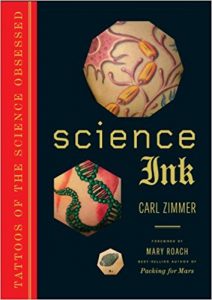Science Ink: Tattoos of the Science Obsessed
In 2007, Carl Zimmer posed a question on his blog: are scientists hiding tattoos of their science? It turned out that many of them were, and they were willing to share their ink with him and the world. Zimmer has posted hundreds of these images in the years since. In Science Ink, he assembles his favorite images from his blog, along with previously unpublished ones, and writes about the science behind the pictures, and the scientists behind the science. From archaeology to astronomy, from neuroscience to chemistry, Science Ink is a guide to the universe, illustrated on the bodies of scientists.
Excerpt
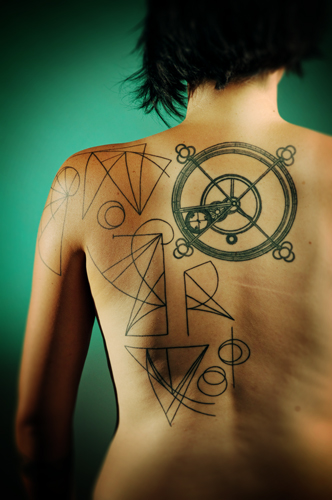 “Although I’m not a scientist by trade,” writes Lauren Caldwell, “my work on seventeenth- and eighteenth-century British literature has provided ample opportunity for me to become acquainted with the work of some brilliant scientific innovators. Though we have discarded some of their ideas, their work retains all of its vital visual force. ¶ “Years ago I discovered and fell in love with the comprehensive diagrams in Giovanni de’Dondi’s 1364 Il Tractatus Astarii, which contained the plans for the first famous astrarium. Each piece has its own delicate mechanical beauty, but I chose for my backpiece the Mercury wheelwork. Of course, you couldn’t track Mercury with it—de’Dondi followed Ptolemy—but his astrarium remains a lovely and impressive testament to human ingenuity and curiosity. ¶“The more spare geometrical diagrams that surround the de’Dondi piece are taken from Sir Isaac Newton’s Principia Mathematica—of which little enough, I imagine, need be said. Though in many respects these two men couldn’t have been more different, they shared a vision of a universe as elegant and aesthetically compelling today as it was when they lived and worked.”
“Although I’m not a scientist by trade,” writes Lauren Caldwell, “my work on seventeenth- and eighteenth-century British literature has provided ample opportunity for me to become acquainted with the work of some brilliant scientific innovators. Though we have discarded some of their ideas, their work retains all of its vital visual force. ¶ “Years ago I discovered and fell in love with the comprehensive diagrams in Giovanni de’Dondi’s 1364 Il Tractatus Astarii, which contained the plans for the first famous astrarium. Each piece has its own delicate mechanical beauty, but I chose for my backpiece the Mercury wheelwork. Of course, you couldn’t track Mercury with it—de’Dondi followed Ptolemy—but his astrarium remains a lovely and impressive testament to human ingenuity and curiosity. ¶“The more spare geometrical diagrams that surround the de’Dondi piece are taken from Sir Isaac Newton’s Principia Mathematica—of which little enough, I imagine, need be said. Though in many respects these two men couldn’t have been more different, they shared a vision of a universe as elegant and aesthetically compelling today as it was when they lived and worked.”
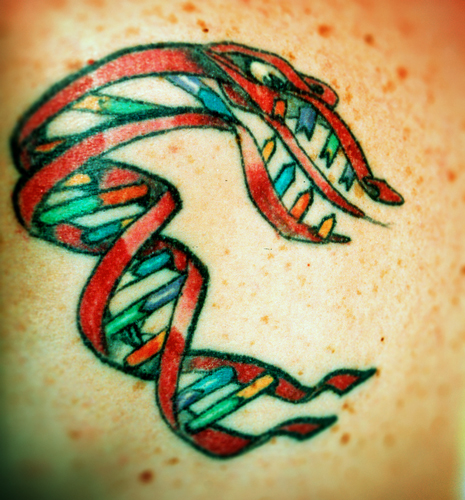 Jay Phelan, a biologist at UCLA, got his DNA tattoo in 1990 while he was in graduate school. “As I got deeper into the study of evolution, genetics, and human behavior,” he writes, “I realized that there was a tension between what my genes ‘wanted’ me to do and what I wanted to do, from the fattiness of the foods I ate, to the selfishness/selflessness I showed to others, to issues with managing my money, my risk-taking, and my relationships, and more. It dawned on me that I was fighting a never-ending battle. Anyway, I tried to come up with a design that captured that tension and, once I did, decided to get it tattooed on my back.”
Jay Phelan, a biologist at UCLA, got his DNA tattoo in 1990 while he was in graduate school. “As I got deeper into the study of evolution, genetics, and human behavior,” he writes, “I realized that there was a tension between what my genes ‘wanted’ me to do and what I wanted to do, from the fattiness of the foods I ate, to the selfishness/selflessness I showed to others, to issues with managing my money, my risk-taking, and my relationships, and more. It dawned on me that I was fighting a never-ending battle. Anyway, I tried to come up with a design that captured that tension and, once I did, decided to get it tattooed on my back.”
 “I got this tattoo as an homage to the pain of my graduate work,” writes Corey Ptak. “It’s a model of fulvic acid, which is a representation of natural organic matter in the soil. I work with this molecule for my grad work, and I figured I might as well get it etched into my skin so I can look at it and say, ‘Well, at least it hurt less than grad school at Cornell.'”
“I got this tattoo as an homage to the pain of my graduate work,” writes Corey Ptak. “It’s a model of fulvic acid, which is a representation of natural organic matter in the soil. I work with this molecule for my grad work, and I figured I might as well get it etched into my skin so I can look at it and say, ‘Well, at least it hurt less than grad school at Cornell.'”
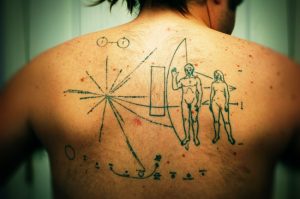 In the early nineteenth century astronomers and other scholars began to think seriously about communicating with aliens. At the time, many of them were convinced that aliens were close by, living on the Moon. To send a message to the lunarians, some proposed digging trenches across the Sahara, filling them with kerosene, and lighting them ablaze. The great mathematician Karl Friedrich Gauss favored clearing vast tracts of Siberian forests to create a gargantuan piece of geometry—a textbook figure of the Pythagorean theorem, perhaps. By the end of the nineteenth century, lunarians had evaporated into myth, but in 1920, Robert Goddard, the inventor of the rocket, was still arguing for humanity to compose messages for aliens. Instead of the Moon, however, he turned his attention to Mars. He urged that spacecraft should be sent to Mars, engraved with figures that Martians might recognize. ¶ In 1973, the dream of Gauss and Goddard became real. The Pioneer 10 probe (p. 239) was launched into space bearing a message for aliens. A gold plaque depicted a naked man and a woman, along with a celestial map (p. 238, top). ¶ The map shows the location of Earth relative to nearby pulsars, which are rapidly rotating stars that unleash regular pulses of radiation “The intervals are very much like fingerprints and are distinct from pulsar to pulsar,” explains Alaina Hunt, an artist and amateur astronomer (p. 238, bottom). “On the map, each pulsar’s period is encoded in binary code. To decipher the period in megahertz, one needs to figure out the binary number then multiply it by 1420 MHz to get the period of each of the pulsars. With the knowledge of relative distance and the pulsars’ periods, one can triangulate the position of our sun.” ¶ Pioneer 11, launched the following year, bore the same plaque. Both space probes have left the solar system and are now hurtling into deep space. Once NASA had finished with the Pioneer probes, they designed a new generation of spacecraft, called Voyager (opposite, bottom). Launched in 1977, it carried a new plaque. It included not only engravings, but was also etched with a phonographic recording of music, natural sounds, and digitally encoded images (opposite, top). ¶ I like to think of these engravings as the ultimate science tattoos. It would be presumptuous to think that aliens will ever see them, though. Voyager has followed Pioneer out of our solar system, where the probes will be spending thousands of years far from another star. We can only hope that an alien civilization will be able to detect tiny spacecraft far from their own planets, adrift in a great void. Even if aliens did scoop up one of our probes, we cannot assume they’d be able to figure out the meaning of their tattoos. It can be hard enough to figure out a science tattoo here on Earth without some help from its owner. ¶ What we do know is that these plaques will escape the fate of every human creation here on Earth. While the pyramids of Egypt and the Empire State Building crumble under the relentless force of wind and rain and rust, the Pioneer and Voyager plaques will last for hundreds of millions of years. They may well become the final traces of our species. They are not a gesture to aliens, then, but to the unimaginable future.
In the early nineteenth century astronomers and other scholars began to think seriously about communicating with aliens. At the time, many of them were convinced that aliens were close by, living on the Moon. To send a message to the lunarians, some proposed digging trenches across the Sahara, filling them with kerosene, and lighting them ablaze. The great mathematician Karl Friedrich Gauss favored clearing vast tracts of Siberian forests to create a gargantuan piece of geometry—a textbook figure of the Pythagorean theorem, perhaps. By the end of the nineteenth century, lunarians had evaporated into myth, but in 1920, Robert Goddard, the inventor of the rocket, was still arguing for humanity to compose messages for aliens. Instead of the Moon, however, he turned his attention to Mars. He urged that spacecraft should be sent to Mars, engraved with figures that Martians might recognize. ¶ In 1973, the dream of Gauss and Goddard became real. The Pioneer 10 probe (p. 239) was launched into space bearing a message for aliens. A gold plaque depicted a naked man and a woman, along with a celestial map (p. 238, top). ¶ The map shows the location of Earth relative to nearby pulsars, which are rapidly rotating stars that unleash regular pulses of radiation “The intervals are very much like fingerprints and are distinct from pulsar to pulsar,” explains Alaina Hunt, an artist and amateur astronomer (p. 238, bottom). “On the map, each pulsar’s period is encoded in binary code. To decipher the period in megahertz, one needs to figure out the binary number then multiply it by 1420 MHz to get the period of each of the pulsars. With the knowledge of relative distance and the pulsars’ periods, one can triangulate the position of our sun.” ¶ Pioneer 11, launched the following year, bore the same plaque. Both space probes have left the solar system and are now hurtling into deep space. Once NASA had finished with the Pioneer probes, they designed a new generation of spacecraft, called Voyager (opposite, bottom). Launched in 1977, it carried a new plaque. It included not only engravings, but was also etched with a phonographic recording of music, natural sounds, and digitally encoded images (opposite, top). ¶ I like to think of these engravings as the ultimate science tattoos. It would be presumptuous to think that aliens will ever see them, though. Voyager has followed Pioneer out of our solar system, where the probes will be spending thousands of years far from another star. We can only hope that an alien civilization will be able to detect tiny spacecraft far from their own planets, adrift in a great void. Even if aliens did scoop up one of our probes, we cannot assume they’d be able to figure out the meaning of their tattoos. It can be hard enough to figure out a science tattoo here on Earth without some help from its owner. ¶ What we do know is that these plaques will escape the fate of every human creation here on Earth. While the pyramids of Egypt and the Empire State Building crumble under the relentless force of wind and rain and rust, the Pioneer and Voyager plaques will last for hundreds of millions of years. They may well become the final traces of our species. They are not a gesture to aliens, then, but to the unimaginable future.
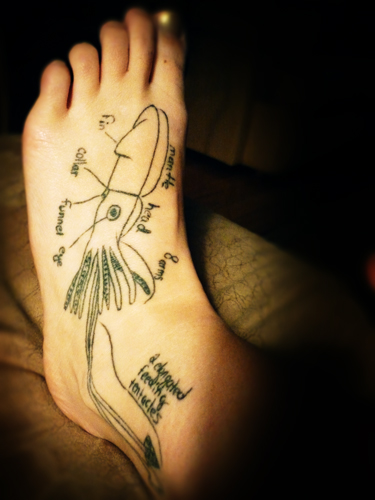 Rebecca Mensch studied squid anatomy in graduate school at Auckland University of Technology in New Zealand, and got a tattoo so that she’d always remember what goes where. It is easy to get such things confused inside a squid. They have three hearts. Their brain is shaped like a donut, and their esophagus passes through the donut hole. Their eyes contains lenses that glide forward and back, like a telescope, rather than the shape-changing lenses in our own eyes. Squid can swim by sucking in water and shooting it back out through vents around their head, looking back at where they’ve been. To attack, they flutter fins to move forward and lash out with their eight tentacles. They draw their prey to their mouth, where they slash it apart with a parrot-like beak. A squid beak is one of the stiffest materials in nature, and yet squid can control it with their boneless bodies.
Rebecca Mensch studied squid anatomy in graduate school at Auckland University of Technology in New Zealand, and got a tattoo so that she’d always remember what goes where. It is easy to get such things confused inside a squid. They have three hearts. Their brain is shaped like a donut, and their esophagus passes through the donut hole. Their eyes contains lenses that glide forward and back, like a telescope, rather than the shape-changing lenses in our own eyes. Squid can swim by sucking in water and shooting it back out through vents around their head, looking back at where they’ve been. To attack, they flutter fins to move forward and lash out with their eight tentacles. They draw their prey to their mouth, where they slash it apart with a parrot-like beak. A squid beak is one of the stiffest materials in nature, and yet squid can control it with their boneless bodies.
What People are saying
“An awesome damn book”
—The Verge
“Zimmer brilliantly animates the intoxicating passions of science lovers in perfectly precise, perfectly poetic short stories.”
—Jad Abumrad, host of “RadioLab” and winner of a Macarthur “genius” grant
“How apt: the most enduring ideas in science translated into that most enduring personal art—the tattoo. Science Ink marries mind and body, and Zimmer reveals the beauty that motivates so many scientists.”
—Sam Kean, author of The Disappearing Spoon
“After spending long hours at the computer, in the lab or field, science has a way of getting under your skin. Science Ink reveals the great ideas and deep passion for science revealed in some of the most creative body art on the planet today. This is a book to revel on the best ideas and discoveries in science and of the passion scientists have for their life’s work.”
—Neil Shubin, University of Chicago, author of Your Inner Fish
“Here is to be found the evidence that scores of intelligent and intellectually perceptive young people recognise that equations, symbols and structures are the key constituents of the elegant language through which the Universe reveals its deeply buried and wondrous secrets. It is a great pleasure to see this compendium of truly moving personal statements about the sciences, collected in this superb book.”
—Sir Harry Kroto, winner of the 1996 Nobel Prize for Chemistry
“Every page of this book is a delight. Be dazzled by the images, wowed by the formulas, and inspired by the stories behind them all.”
—Sean Carroll, author of From Eternity to Here
New Scientist
“When Carl Zimmer asked on his blog whether tattoos were common among scientists, he unwittingly became the curator of a set of incredible images, and of intimate stories that reveal a love affair with science. We are familiar with the idea that people tattoo themselves with a name or symbol representing the great love in their life. Those who love science are no different. Zimmer was inundated with responses.
“Many are literal representations of a scientist’s obsession with their profession: a tree of life covering a zoology graduate’s back, or a cross section through a mountain chain for a geology student. Others tell more personal stories, such as the neuroscientist with a tattoo of the type of nerve cell that is damaged in Lou Gehrig’s disease, which killed her father. This book gathers up the marvels of science that have touched people so deeply they wanted to embody them. Zimmer’s explanations of these concepts turns what could have been a gimmicky coffee-table picture book into an informative guide to some of the most captivating ideas in science.”
Science News
“Watch out: This is the kind of book that might give readers some wild ideas. It’s also the kind of subject that makes other science writers wish they had thought of it first.”
Irish Times
One of the most eye-catching tomes to come out recently is Science Ink: Tattoos of the Science Obsessed, by Carl Zimmer . Using the body art as a jumping-off point, Zimmer eloquently relates the meanings behind tattoos that depict symbols and equations from fields such as maths, biology, astronomy, neuroscience and physics.
MSNBC
This is not your typical coffee-table book. First, it’s handy enough to sit on a shelf, thanks to its 7-by-10-inch size. But more importantly, it’s not just an assemblage of 200 amazing tattoos inspired by scientific symbology. Zimmer tells the tale behind each tattoo … and the science that inspired it. Think of it as a survey course on the cosmos, written on skin.
io9
Usually the author of serious, meaty books about evolution and biology, Zimmer shows us his whimsical side in this coffee table book featuring gorgeous photographs of people who have science tattoos. This book is a nothing short of a love letter to science, and to the people who are so enchanted by it that they’ve marked their bodies with its symbols.
Nature
Science Ink is packed with fascinating stories. One of the most moving is Abigail’s. A chemistry student, she sent in a photo of her tattoo — the word ‘entropy’ inked on her back. A few months later, her mother sent Zimmer a note saying that Abigail had died in a car accident and that she was getting her daughter’s tattoo replicated on her own body. That blog post and the comments it generated became a memorial for Abigail, and eventually led to a posting by a woman whose mother had received Abigail’s lungs after her death.We call tattoos permanent, but they last only as long as the body that wears them survives. Abigail’s tattoo has a life beyond her own: the design now adorns the headstone marking her grave. And it is there in the pages of Science Ink — one of many signs of an enduring fervour for science, and a new chapter in the age-old history of body art.
Publisher’s Weekly, Starred Review, October 10, 2011
Noting a colleague’s DNA-inspired tattoo at a pool party, science writer Zimmer (A Planet of Viruses) wondered how widespread the phenomenon of the inked scientist was. He solicited pictures for his blog, “The Loom,” and, inundated with photos and stories from scientists and laypeople alike, quickly became a curator of science-inspired body art. Mary Roach’s foreword lays out why, given the passion with which so many approach their fields, it should be no surprise to encounter this worldwide tribe whose obsessed love for every far-flung corner of science’s domain was marked permanently on their bodies. Divided into 13 sections, the book is filled with breathtaking color photos accompanied by grounding texts: Portuguese geneticist Dônovan Fereira Rodrigues, who got Isaac Newton’s “shoulders of giants” quote inked on his back, tells the story behind the phrase; August Kekule’s “discovery” of benzene’s structure inspired Virginia pharmacology PhD. Jeffrey Ikeda; a tattoo of Nikola Tesla’s visions of a wireless future lies on the arm of Abraham Orozco, the science director of a children’s community center in L.A. Genetics, neuroscience, and evolution (Darwin gets his own section) form the book’s modern cornerstones and the tattoos range from full back pieces and sleeves to little—often concealable—personal reminders. Encyclopedic in essence, Zimmer’s coffee-table art book presents a wealth of material.
